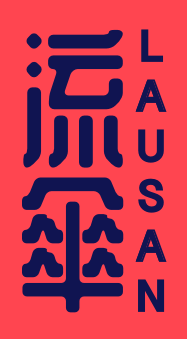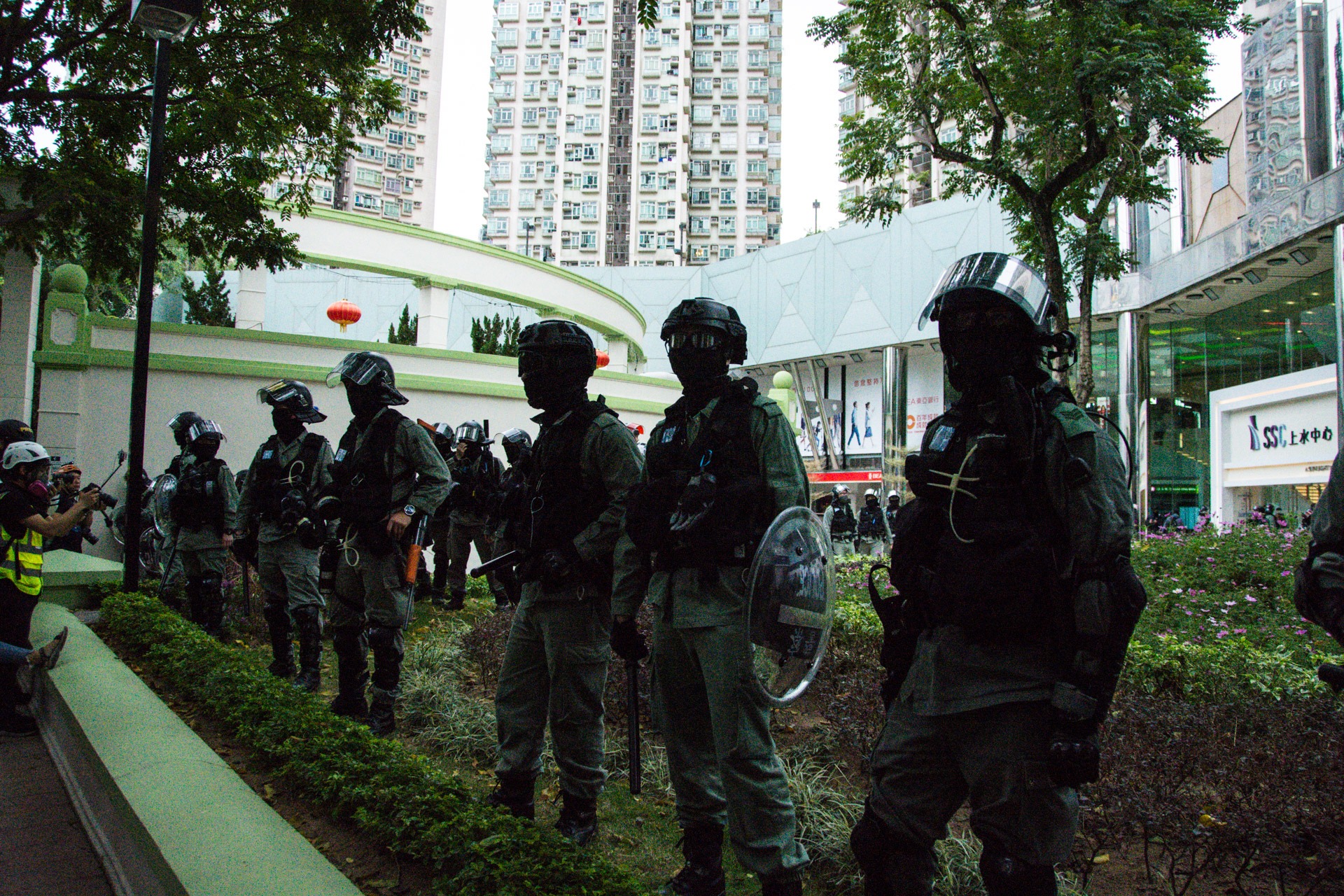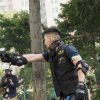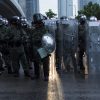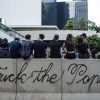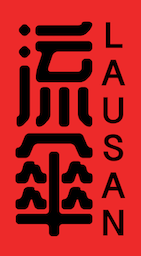Originally published in The Nation. Republished with permission.
As pro-democracy protests in Hong Kong have turned more violent and disruptive, spectacular scenes of front-liners wielding fiery arrows and Molotov cocktails have dominated international coverage. Black-clad protesters have become icons of the uprising—and been forced to shoulder the blame for the destruction of the city. But that narrative obscures a driving force behind their actions, one supported by many of their fellow Hong Kongers: resistance to the brutality of the Hong Kong Police Force (HKPF), and to the government that has so far refused to hold the police accountable.
The protests, which were sparked by a now-withdrawn bill that would’ve allowed people in Hong Kong to be extradited to mainland China, began peacefully in June. But continued violence and other misconduct by the police—from beating compliant arrestees with batons to alleged sexual assault of detained protesters, to refusing to show identification when asked—has pushed some protesters to both fight back and barricade themselves in universities rather than risk arrest.
Many Hong Kongers have called for the actions of the police to be investigated by an independent council and for the HKPF to be held to account. But despite condemnations of police violence by everyone from Amnesty International and Human Rights Watch to the medical workers who have seen protesters’ injuries firsthand, only one police officer has been disciplined for excessive force against protesters this year.
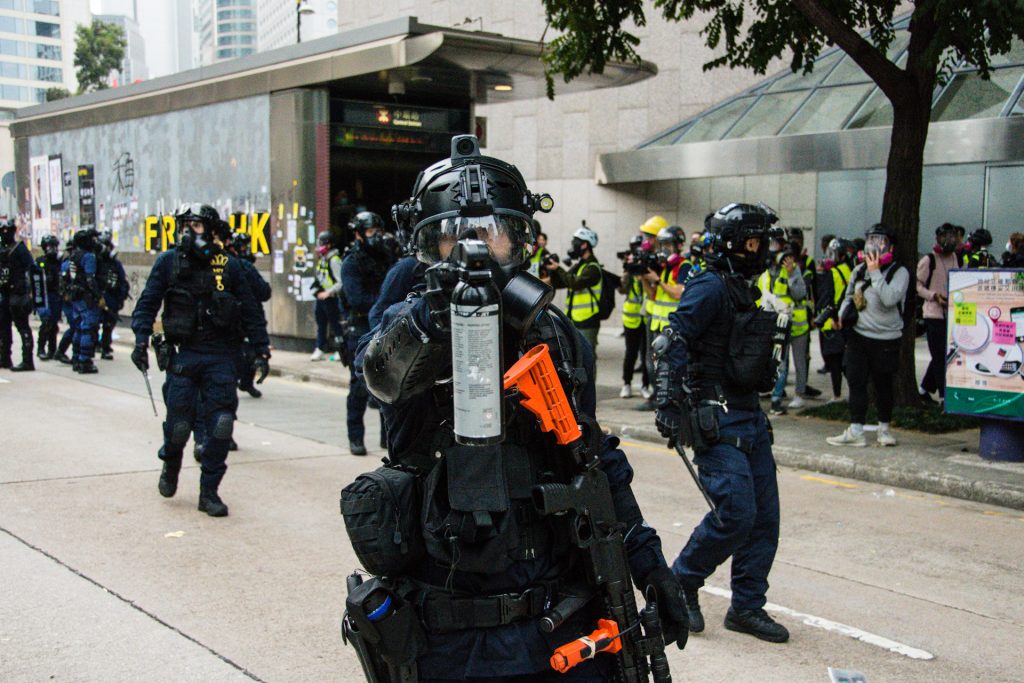
The Hong Kong government does have a civilian body meant to provide oversight of the police: the Independent Police Complaints Council. But critics say it’s made up of conservative, pro-government figures. And earlier this month, a leaked document revealed that a panel of experts appointed by the Hong Kong government found the IPCC incapable of handling the independent investigation needed, citing “a shortfall in IPCC powers, capacity, and independent investigative capability necessary to match the scale of events and the standards required of an international police watchdog operating in a society that values freedoms and rights.”
Those on Hong Kong social media—especially on Twitter and some channels on Telegram, the secure messaging app preferred by the protesters—have made a concerted effort to document and publicize police brutality. #HongKongPoliceBrutality and #HongKongPoliceTerrorism are just two of the hashtags Hong Kongers use on Twitter as they recirculate videos and graphics contextualizing the violence. These netizen-protesters see themselves as being on the front lines of the information war over Hong Kong, coordinating a PR campaign to raise awareness—and get the international attention that they see as crucial to their movement’s success.
These netizen-protesters see themselves as being on the front lines of the information war over Hong Kong.
These nonstop conversations have created an overwhelming amount of data, from eyewitness reports of police abuse to the debunking of fake news and propaganda. To that end, two major citizen-led projects have organized the mass of evidence of suspected police misconduct in order to build a case against the law enforcement establishment.
The editors and administrators behind both initiatives—which include an investigative report compiled by the volunteer group NOPAID and the crowd-sourced police brutality database on the pro-democracy website HKrev.info—hope that transnational bodies may one day use these archives to hold the HKPF and the Hong Kong government accountable. And as the territory’s chief executive, Carrie Lam, continues to sidestep allegations against the HKPF, both projects make the argument for an independent investigative panel outside of the current police accountability system.
“The main purpose of documenting and preserving the database is that it will show the world what we Hong Kongers are confronting, thereby securing sympathy and assistance from the international community. We hope that the day will come when the police will be tried and our database would be a powerful evidence of their atrocity,” an administrator of the police brutality database who goes by the name Chronicler told The Nation. (Many involved in these initiatives choose to remain anonymous, out of fear of repercussions.) “Our [other] mission is to keep a comprehensive historical record of our revolution so that we, and our future generations, will never forget the heavy price we are paying for freedom, democracy, and justice.”
One of the first major condemnations of police brutality in Hong Kong this year came right after the protests began, when police unleashed beanbag shots, tear gas, and rubber bullets to disperse thousands of demonstrators on June 12. Amnesty International called this an “unnecessary and excessive use of force by police” on “largely peaceful protesters.” But then–Hong Kong Police Commissioner Stephen Lo Wai-Chung not only justified the violence but escalated the conflict, calling the clash “a riot”—in a place where riot charges can land arrested protesters in jail for up to a decade.
Hong Kongers responded by staging the biggest protest the territory has ever seen just a few days later, with an estimated 2 million people taking to the streets to demand not only the retraction of the extradition bill but also the retraction of the riot claim and the release of arrested protesters. On July 1—the anniversary of the territory’s handover from the United Kingdom—protesters stormed and vandalized the Legislative Council.
But then, on July 21, a mob reportedly connected to the triads, as some organized crime groups are known in Hong Kong, assaulted protesters and passersby at the Yuen Long railway station, injuring at least 45 people. The police took over half an hour to arrive at the scene, causing many to speculate that the police were colluding with gangs to intimidate protesters. Then, in October, a police officer shot an 18-year-old student in the chest at close range. The police officer was not disciplined, but the student was charged with rioting and assault.
The failure of 2014’s mostly peaceful Umbrella Movement to obtain substantive gains has led some protesters to adopt more spontaneous guerilla tactics. The outrage over the police’s behavior—and the government’s reluctance to meet their demands—have helped to turn some protesters increasingly radical, even violent. The vast majority of Hong Kong protesters are peaceful, but some front-liners have used petrol bombs and Molotov cocktails to ward off the police.
Over 90 percent of the stations for Hong Kong’s subway system, Mass Transit Railway (MTR), have been vandalized since June, following protesters’ accusations that the MTR Corporation had done the government’s bidding by shutting down subway stations near sites of unrest. Bystanders have paid the price of these clashes too: Earlier this month, a 70-year-old sanitation worker died after he walked into a confrontation and was hit in the head with a brick.
Meanwhile, reports of police brutality have escalated in kind—especially since November 8, when a 22-year-old college student died from injuries sustained while reportedly fleeing tear gas. Since then, police officers have shot a 21-year-old front-liner, attempted to storm the Chinese University of Hong Kong after protesters barricaded themselves inside, and kettled around 1,500 protesters inside the Polytechnic University of Hong Kong. The journalist Laurel Chor, reporting from PolyU, estimated on November 21 that around 50 people were still inside the university, with everyone else having surrendered, escaped, or arrested; as of November 26, just a handful of people were thought to still be inside. Since the protests began, nearly 4,500 people have been arrested.
The tactics of the Hong Kong police have catalyzed and sustained public anger against the government. Of the protesters’ now-famous five demands, three call for reining in law enforcement: Protesters demand an independent inquiry into police brutality, amnesty for those arrested, and an end to characterizations of protests as “riots.” The New York Times reported in early October that the Hong Kong police is now “a symbol of what many protesters regard as the unchecked power with which Beijing governs the semiautonomous Chinese territory.” It is no surprise, then, that a sixth demand has emerged from some protesters: a call to disband the police.
Back in June, a volunteer group of Hong Kong professionals sensed that the government would not holding the police accountable and decided to take matters into their own hands. They would eventually call themselves Netizens Organizing Police Abuse Investigation Data (NOPAID). “There were few calls for establishing an independent committee [then]; the government was also not paying attention. So we thought, what if we tried collecting data [on police abuses] as a first step?” a member of NOPAID told The Nation over Telegram. “We believed that only through examining, then analyzing, the entire police force’s…legal foundations that we could possibly hold them accountable later on.”
Soliciting the help of anonymous legal professionals on Facebook and LIHKG (Hong Kong’s version of Reddit, which also functions as a public forum for crowdsourcing and organizing protests), NOPAID compiled an extensive report, first released in July. (A new edition was published in September.) It reviews and specifies weaknesses in the current accountability system and lays out evidence of suspected systemic abuses by the police force between June 10 and October 2 of this year.
‘We believed that only through examining, then analyzing, the entire police force’s…legal foundations that we could possibly hold them accountable later on.’
About 10 people cowrote the 381-page report, including over 200 pages detailing day-by-day instances of alleged police misconduct, with screenshots of videos and live streams gleaned from both social media and news organizations to back them up. (One editor gave a conservative estimate that they have collected over 1,000 videos that substantiate their claims.) The reports are available in both Chinese and English, and were uploaded by a member based in the United States—which a NOPAID editor told The Nation was “completely for safety reasons.”
Drawing on public records readily available online, the NOPAID report points out that of 2,119 complaints about police beatings submitted to the IPCC between 2011 and 2018, the IPCC only confirmed two. (And, as Sing Tao Daily has reported, only one officer was prosecuted for any misconduct during that entire period.) It also explains that the “passive role” of the IPCC means it has “no power to investigate, file a case or to take disciplinary measures, and…cannot compel the HKPF” to do so either. NOPAID alleges that at least 20 of the 29 incumbent members of the IPCC are linked to the pro-establishment camp or Chinese business interests in some form; some even have direct ties to the Chinese People’s Political Consultative Conference, an advisory body for the Chinese government.
One NOPAID editor told The Nation that he hoped their work could “provide an objective basis upon which locals and foreigners could know the truth and discuss”—a centralized database that would allow for easier and more “powerful” collection of evidence.
“The escalation we’ve seen so far has been horrifying,” he added. “The unlawfulness of the police has become more serious after the mask ban and the fourth plenary session, involving firing real bullets, abuse, rape, as well as the discovery of many corpses with unknown causes of death”—a reference to the allegation that an uptick in suicides and discovery of dead bodies in Hong Kong could be linked to the government or police misdeeds. The NOPAID team stopped publishing updates after October, citing lack of resources and time. But the Chinese version of the police misconduct database on HKrev.info is still being updated almost daily.
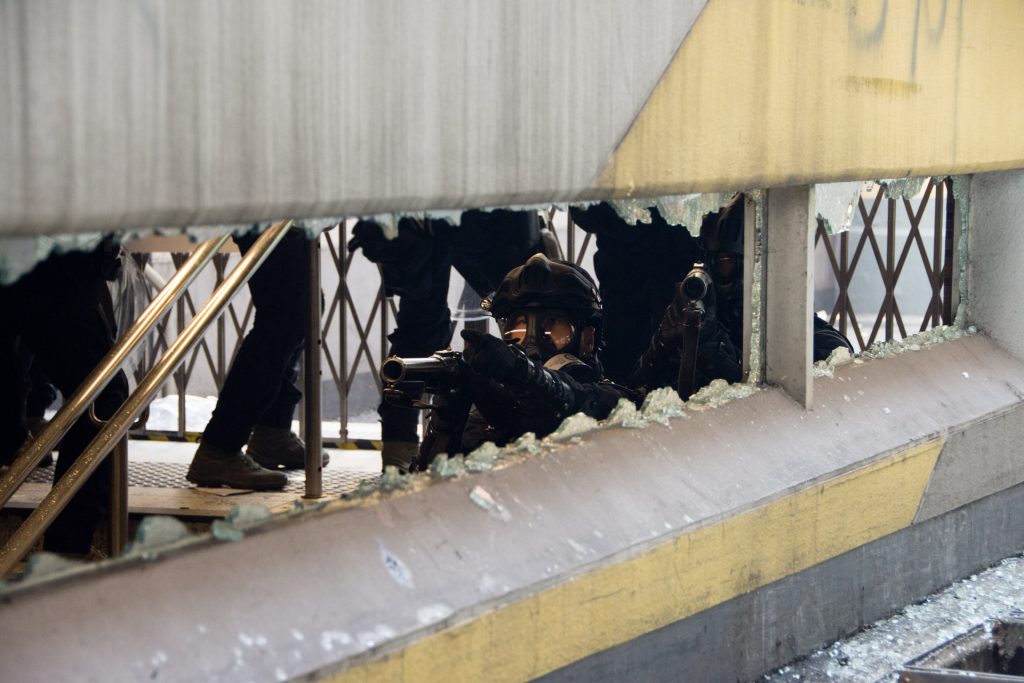
HKrev.info is a volunteer-run aggregator of news and protest schedules, which also archives news and ephemera related to what it calls the Hong Kong 2019 Democratic Movement. Since early October, it has also hosted the police misconduct database. Published in four languages, the Chinese version of the database documents over 1,000 incidents of abuse by the HKPF, complete with links to sources for every allegation. This includes 222 cases of alleged “use of excessive force,” 346 cases of alleged “improper use of weapons,” 286 cases of alleged “abuses of police power,” 199 cases of alleged “intimidation, threats, and verbal violence,” and 80 cases of “collusion with and covering up for ‘black forces’” (referring to counterprotesters and triads).
The database began after the assault by triad-connected mobs on July 21. A group of five people in Hong Kong who had connected via LIHKG began compiling a list of suspected instances of police misconduct using Google Slides. The person who goes by Chronicler told The Nation that when “the sheer number of cases had overloaded the system, making it laggy and difficult to organize,” they migrated the data onto its current site.
It’s now maintained by around 30 people in their 20s and 30s, who add cases as soon as someone is able to provide videos or photos, information about when and where the incident happened, and an explanation as to why they suspect police misconduct. No incidents can be uploaded to the database without photographic evidence. (To streamline the process, the admins set up a bot account on Telegram to helps take in submissions.)
The incidents documented range from property damage to protesters’ being beaten by police. Chronicler believes that the database presents these events “in a way that strives to show the full picture of each and every incident,” and that perusing the extensive database will also show foreign observers “why the protesters have to [escalate] their offensive and defensive capabilities as a means to protect themselves and those around them.”
The host site, HKrev.info, hews close to the principle of decentralized organizing preferred by the protesters. “All of our members work at our own time and space with one goal in mind—that is, to relay messages and the current situation of the movement as quickly as possible, and as accurately as possible,” a volunteer for HKrev.info told The Nation, expressing gratitude for everyone who contributes. “There is no ‘big boss’ in the group when all members contribute as much as they can at the pace our volunteers wish.”
Meanwhile, the Hong Kong government has consistently refused to address concerns about police misconduct, even after instances of protesters’ being shot. In August, local outlet Stand News reported that during a visit to a police station, Carrie Lam had promised there would be no independent investigation into alleged police brutality, as “it was the only thing [she] could do for the police force”; in a recording leaked to Apple Daily, Lam acknowledged that although many wanted an inquiry into police misconduct, her “colleagues in the police force were very resistant.”
‘There is no “big boss” in the group when all members contribute as much as they can at the pace our volunteers wish.’
Multiple local and international outlets have found that the police force has improperly deployed crowd control munitions, such as pepper ball guns and tear gas. (The United Kingdom banned sales of tear gas to Hong Kong in June, and the US Senate just passed a bill to ban sales of tear gas and other weapons to the HKPF.) Journalists have been roughed up by the police, arrested, and injured; one was permanently blinded in one eye by a rubber bullet. There have even been allegations of sexual assault by the police.
In one instance, lawyers representing the survivor of an alleged gang rape by police slammed the police for “systematically work[ing] to discredit her and to undermine her complaint.” The only officer facing consequences thus far is one who, in a viral video, repeatedly drove a motorcycle into a small crowd of protesters; he was suspended and put on mandatory leave.
With the landslide victory of the pro-democracy camp in the local District Council elections on November 24, it is clear that a majority of Hong Kongers back the five demands, seeing complete democratic reforms as one of the only means by which state actors like the police may be held accountable. With voter turnout exceeding 70 percent, the city saw a peaceful weekend for the first time in months. But there is a good chance that protesters may soon return to the streets.
So far, neither the Hong Kong nor the mainland Chinese governments have acknowledged the NOPAID report or the police misconduct database. Nor have they been widely referenced in English-language media. And although HKrev.info’s Twitter account has more than 4,600 followers and the English version of the NOPAID report’s release was retweeted more than 8,600 times, it’s unclear how much influence either initiative has exerted over the greater discourse about the Hong Kong protests—or that about the police.
The IPCC recently claimed that it is still committed to releasing a report in early 2020 that will reflect on this year’s events, making “recommendations to the Commissioner of Police and the Chief Executive on how police practices and procedures may be improved.” But Chronicler said they doubted that anything short of radical change would quell the movement—or their documentation of it.
“Disbanding the Hong Kong Police Force and forming an Independent Inquiry Commission is a start. Universal suffrage of the legislature and the Chief Executive, as enshrined in the Basic Law, is the long-term goal,” they said. “Civilians have been raising these demands for months. Only by addressing our demands can the crisis be stopped.”
